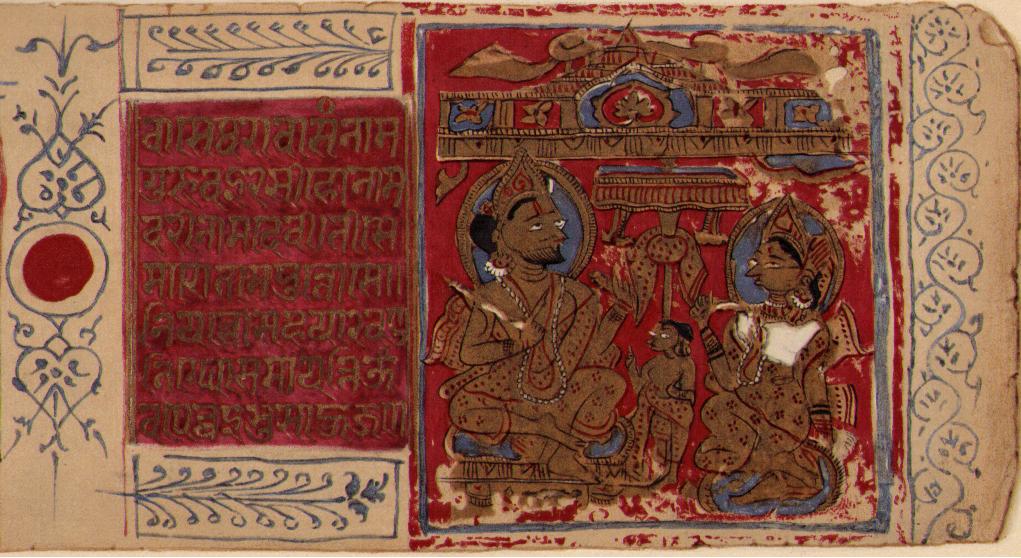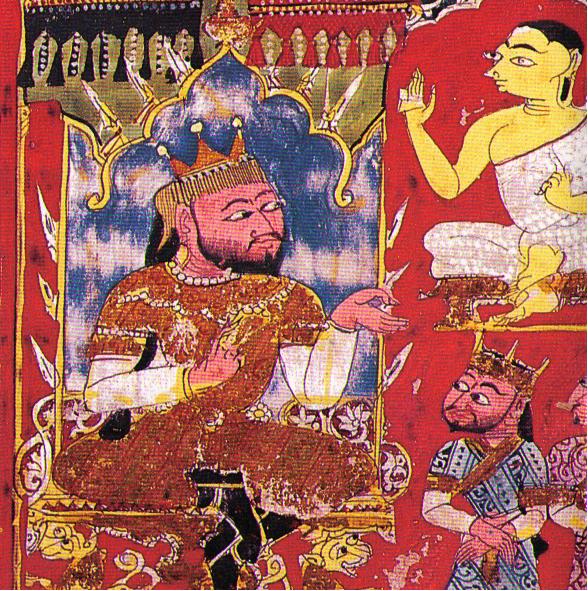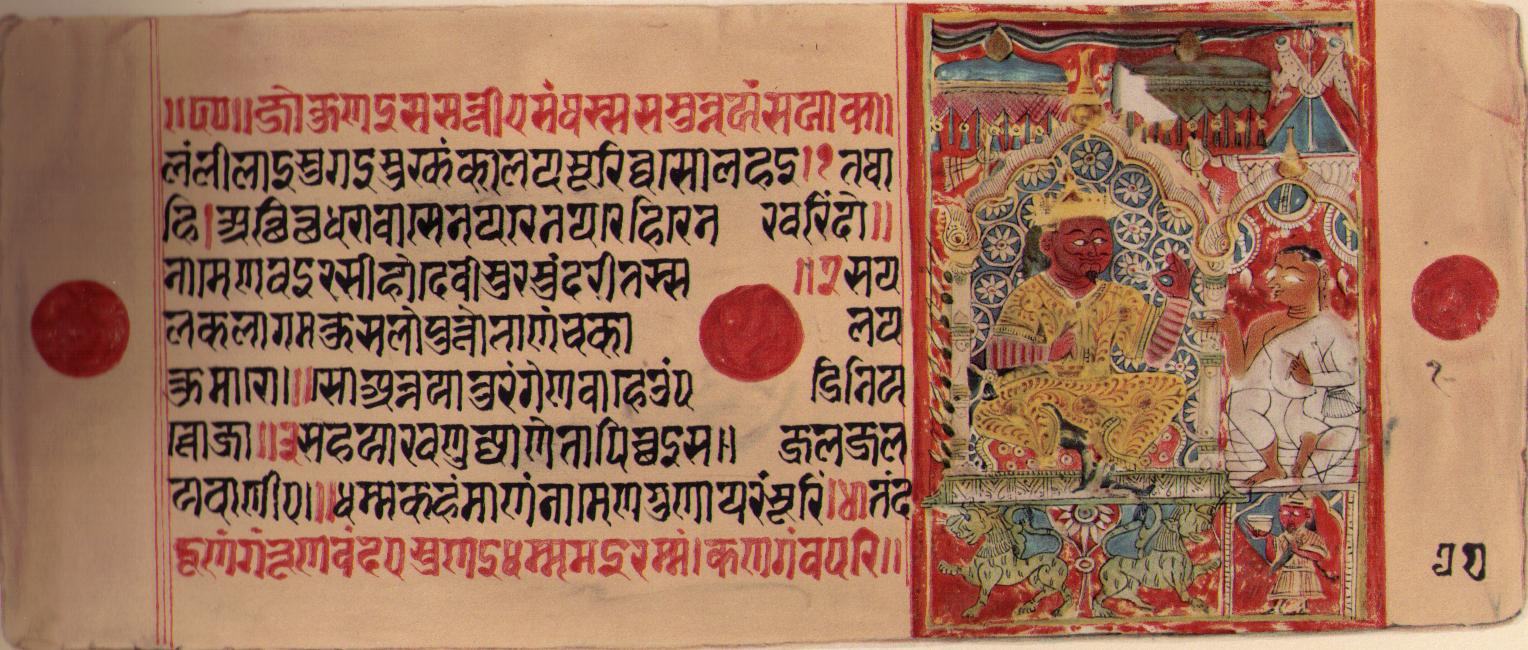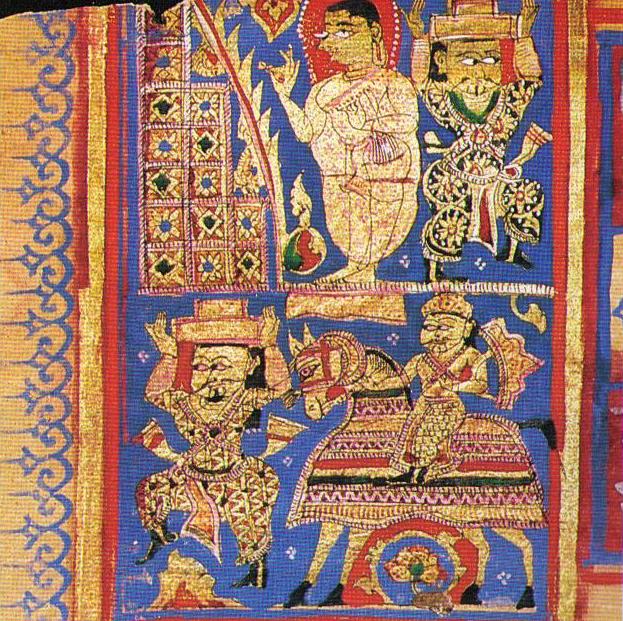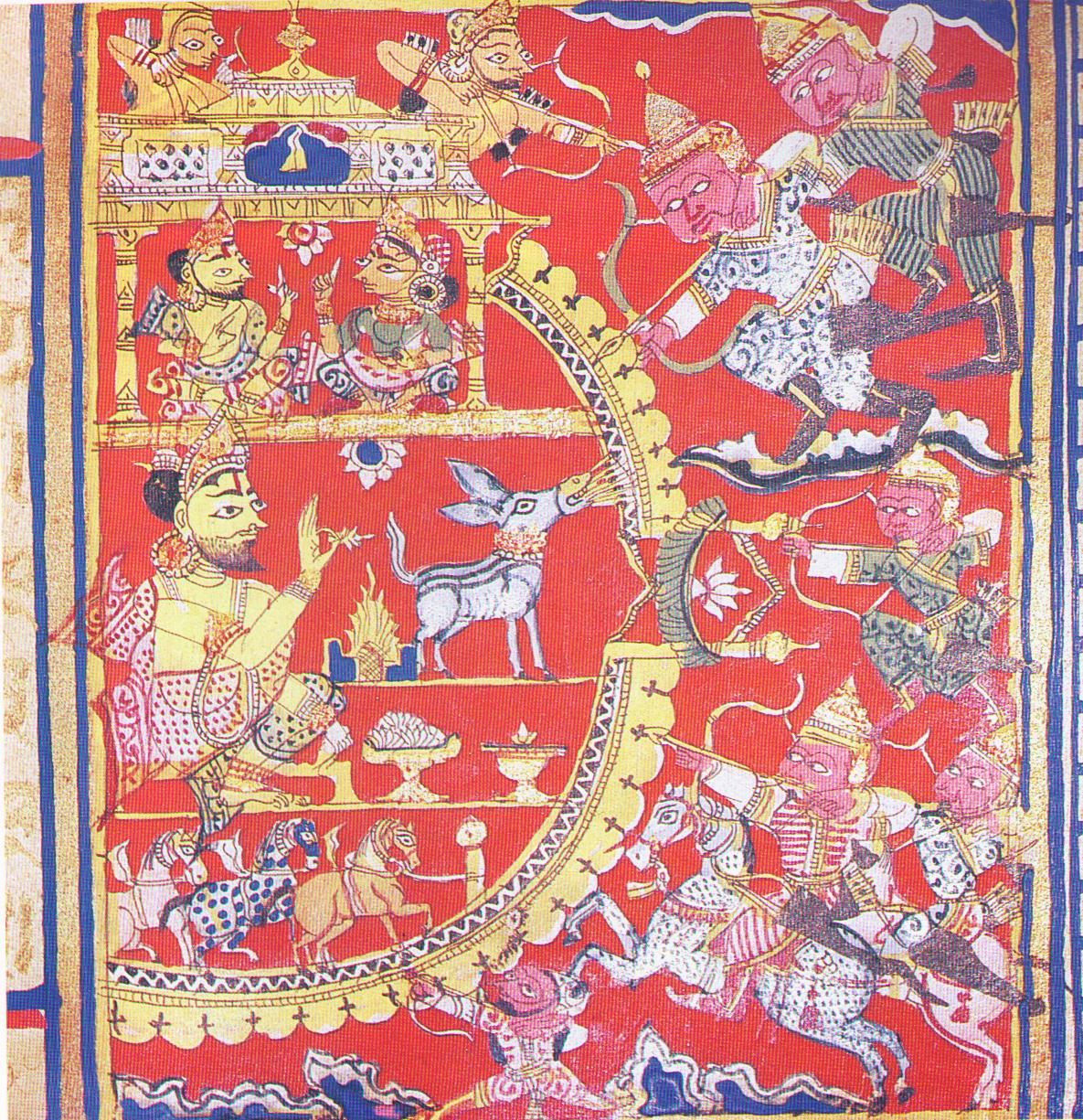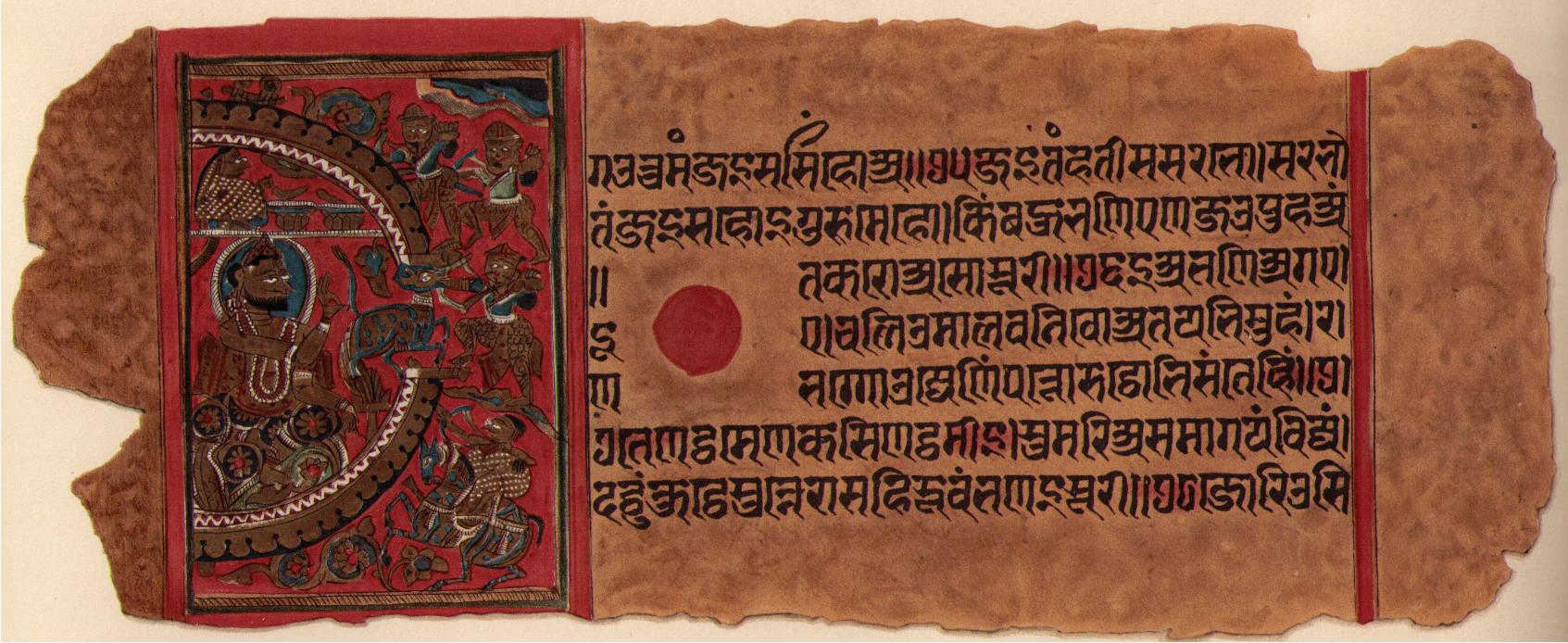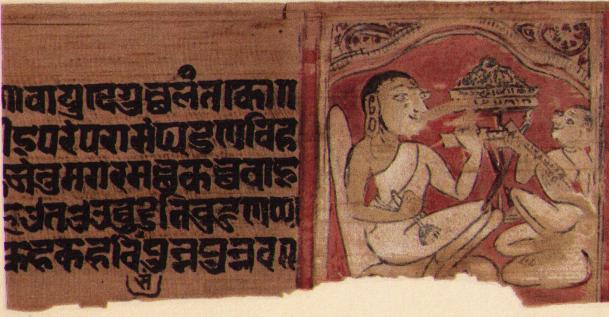The Story of Kālaka
A Brief Introduction to a Less Known Śvetāmbara Hagiography Related to the Date of Paryuṣaṇā
1. Introduction
2. Textual HistoryThe upcoming Paryushan Parva (Paryuṣaṇā) is a good reason to remember the Śvetāmbara hagiographical narrative of the Ācārya Kālaka, which is associated with the date of this festival in a legendary manner. Once this legend was a part of the educational background of every Jain and was read to the monks during the first night of the festival, but today it is less known, even among literate people, and rather an object of indological researches.
The primar intention of this article is to introduce the story of Kālaka to the interested public. So the legend is briefly renarrated and some aspects of the academical discussion will be presented, e. g. history of reception, manuscript tradition and the date of origin.
Since the preserved manuscripts of the Kālaka's legend enclose some of the masterpieces of Jaina miniature painting, every paragraph of this article is completed by such a picture. Remarkable here is the lack of illustrations in the second episode, which led to the assumption, that this part was added to the legend at a later time.
Fig. 1:
Kālaka requests his parents king Vajrasiṃha and queen Surasundarī for the permission to become a monk. The king is enthroned under a canopy, holding a sword while his wife is depicted to his side, slightly below sitting on a carpet. Kālaka stands between his parents under a parasol.
Undated paper manuscript of the Kālakācāryakathā, c. 15th century CE, Miniature Painting of Western Indian Style (Reference: W. Norman Brown: The Story of Kālaka. Texts, History, Legends and Miniature Paintings of the Śvetāmbara Jain Hagiographical Work The Kālakācāryakathā. Washington 1933, Fig. 14).
3. The Story of Kālaka According to the 'Long Anonymous Version'The story of Kālaka is told in the Kālakācāryakathā, which is usually added on the end of the Kalpasūtra (after the Paryuṣaṇākalpa) but the central character is also mentioned in other text sources, e. g. the Yogaśāstravṛtti of Hemacandra. In addition an Ārya Kālaka is itemized in the list of Sthaviras as descendant of the Gautama gotra (Hermann Jacobi: Jaina Sūtras Part I. The Kalpa Sūtra. Sacred Books of the East Vol. 22, Oxford 1884/Reprint Delhi 2002, p. 294).
The Kālakācāryakathā has been bequeathed in various manuscript accounts, where several versions however diverge in substance. All have in common the structure of the text, which is composed in four episodes. The most completed manuscript account is the 'Long Anonymous Version', an undated text written in Prakrit. The following abstract of the story is based on this version. According to W. Norman Brown (The Story of Kālaka. Texts, History, Legends and Miniature Paintings of the Śvetāmbara Jain Hagiographical Work The Kālakācāryakathā. Washington 1933) one can distinguish less than four more versions of the tradition:
- Haya-paḍiṇīya-payāvo version (Prakrit)
- Versions of Bhāvadevasūri and Dharmaprabhasūri (Prakrit)
- Version of Bhadreśvara's Kathāvalī (Prakrit)
- Śrīvīravākyānumataṃ Version (Sanskrit)
Most of these versions are available in several manuscript accounts. These various recensions of the legend led to significant differences in the contents between the different versions and avoided an unitary edition at last.
Fig. 2:
Kālaka at the court of the Sāhi. The Sāhi king is sitting on a throne supported by lions (Siṃhāsaṇa) and sheltered by an ornamented baldachin. Two subordinated Sāhis approach from the right, while Kālaka is depicted preaching above. A characteristic of paintings of the Kālakācāryakathā manuscripts is the portraiture of the Sāhi king, as he is depicted as a persian or mongolian warrior to emphasize his foreign parentage.
Undated paper manuscript of the Kalpa Sūtra and Kālakācāryakathā from a Jain Bhandara (Jaisalmer), c. 1400 CE, Western Indian Style, Gujarat/Rajasthan (Reference: Saryu Doshi: Masterpieces of Jain Painting (MARG Publications) Bombay 1985, p. 126, Fig. 6.)
4. Date and Origin of the LegendThe first episode begins with the describing of Kālaka's royal parentage and his admittance into the Jaina order, which involved the ordination of his younger sister Sarasvatī shortly afterwards. Surrounded by 500 monks the Sūri Kālaka arrived in the city of Ujjayinī, where Sarasvatī was forced into the seraglio of king Gardabhilla, ruler of Ujjayinī, against her will. Kālaka tried to persuade the king of his misconduct and requested the release of his sister without avail. Even the advice of the king's ministers to free the nun was unsuccessful, the lust made the king unable to change his mind. So Kālaka left the city of Ujjayinī. He was powerless against Gardabhilla since the king got his strength from a magical 'She-Ass', whose yelling killed all living beings. After instructing the fourfold Congregation (monks, nuns, laymen and laywomen) the Sūri left the order and travelled alone to the western bank of the Indus, which was called Śakakūla. This land was ruled by the Sāhis, whose supreme king was called Sāhāṇusāhi. Kālaka found shelter at the court of a certain Sāhi. After a while this Sāhi fell from grace with the Sāhāṇusāhi, who sent him a sword to kill himself by cutting off his head. But the Sūri dissuaded his host from committing suicide. Instead he advised the Sāhi to leave Śakakūla and to go to the land of Hinduka, accompanied by another 95 disgraced Sāhi kings. So they went south and came to Surāṣṭra, where the rain stopped the trek and the kings divided the realm of Surāṣṭra into 96 parts and stayed there for now. After a certain time Kālaka advised the Sāhi to crusade against Ujjayinī, for this was the key to the land of Mālava. But to arrange the troops the Sāhi king needed some supplies, so the Sūri sprinkled a bunch of bricks with magical powder and turned it all into gold. After dividing these riches they set out to Ujjayinī. On the way the king of Lāṭa joined them and together they arrived at the border of Mālava. In the meantime Gardabhilla heard about the approaching of the enemy and he went out to defend his realm. After a close fight the army of Gardabhilla fled from the enemy's superiority and the king himself retired into the fortress of his capital. The victorious army of the Sāhi kings beleaguered the city of Ujjayinī and offered a decisive battle day by day, but Gardabhilla was prepared for the siege and denied the fight. Then one day the Sāhis messengers found the citadel of king Gardabhilla deserted. When Kālaka heard this, he knew that Gardabhilla planned to defeat his enemies by using the magical power of his 'She-Ass'. He instructed the forces to prospect for the mare and warned them against her bray. Then he advised the kings to depart from the citadel and took 108 bowmen to go to the place where the messengers saw the 'She-Ass'. When the mare opened her mouth to bray the bowmen filled the mouth with arrows and the danger was averted. Subsequently the Sāhis army entered the city of Ujjayinī and captured Gardabhilla. The disempowered king was brought to Kālaka, who reproached him detailed with his malpractices. But the Sūri realized that Gardabhilla was unable to improve since he was bound into painful karma. So he was banished and had to leave Mālava. The Sāhi however to whom Kālaka has once resorted, became the supreme king of the realm while the rest of the Sāhis established as his vassals. According to the Jaina tradition thus arose the line of Śaka kings.
Here it has to be mentioned that this episode of the 'Long Anonymous Version' lacks of a scene, which is a popular subject of miniature painting and which is described in Samayasundara's account of the legend: When Kālaka arrived at the Sāhis realm, he met some crying boys at a well whose ball had fallen into it. The Sūri asked for a bow and shot an arrow into the well striking the ball. Then he followed up with another arrow and another, each piercing the previous, and in the end he had a chain of arrows to pull up the ball from the well.
Fig. 3:
Kālaka at the court of the Sāhi. Kālaka is depicted on a throne opposite to the Sāhi king, preaching a sermon. Beneath the Sūris seat the messenger of the supreme Sāhi king (Sāhāṇusāhi) is depicted, holding the sword with which the Sāhi had to cut off his head and a dish to carry the head to his master.
Paper manuscript of the Kālakācāryakathā from the Vijaya Dharma Lakṣmī Jnāna Mandira Library (Agra), V.S. 1549/1492 CE, Miniature Painting of Western Indian Style (Reference: W. Norman Brown: The Story of Kālaka. Texts, History, Legends and Miniature Paintings of the Śvetāmbara Jain Hagiographical Work The Kālakācāryakathā. Washington 1933, Fig. 22).
The second episode begins with Kālaka's triumphal return to Ujjayinī. At the same time the two nephews of the Sūri on his sister's side, Balamitra and Bhānumitra, were king and heir apparent of Bhṛgukaccha (Bharuch), a seaport at the banks of the Narmada River. They had a sister, named Bhānuśrī, and she had a son named Balabhānu. When Balamitra and Bhānumitra heard about their uncle's return from the western bank of the Indus, they sent their priest Matisāgara to Ujjayinī to invite the Sūri to Bhṛgukaccha. To confirm his demand he praised his sovereign's veneration towards Kālaka. The Sūri accepted the invitation after reporting the Sāhi king and left Ujjayinī towards Bhṛgukaccha. Upon arrival he was received by the local gentry and the royal suite with honour and devotion. After salutation the Sūri delivered a sermon. These words inspired prince Balabhānu to ask for initiation. According to regulation, Kālaka asked the relative's permission and then he accepted the prince into the order. But this incident had consequences: Following the example of Balabhānu large sections of the townspeople devoted to the Jaina religion. This aroused suspicion amongst the royal priests. So the chaplain called on Balamitra to incite the king to turn against the 'heretics', who disobeyed the authority of the three Vedas. But Kālaka, also present to the audience, silenced the chaplain completely by many convincing arguments. Humiliated by the Sūri the chaplain resorted to trickery and persuaded the king to send Kālaka away. Balamitra accommodated the chaplain's demand at last and ordered the giving of improper alms to the monks. Kālaka understood the king's intention and decided to leave the city of Bhṛgukaccha with his disciples, even though the Paryuṣaṇā season was imminent. They wandered to the city of Pratiṣṭhāna where king Śālivāhana ruled, a devoted lay follower. The Sūri instructed the monks not to observe the Paryuṣaṇā until they arrived. After arriving at Pratiṣṭhāna they were inducted with great resplendence and all Jina images were honored. But in the land of Mahārāṣṭra on the fifth of the bright half of the month Bhādrapada a festival of Indra with a great procession was used to be celebrated. So the king Śālivāhana asked the Sūri to delay the Paryuṣaṇā for he feared much confusion if he could not attend all his religious duties at the same time. But Kālaka denied the request since Mahāvīra himself once ordered his Gaṇadharas that the Paryuṣaṇā might not come later than the night of the fifth. Then the king suggested to let it come on the fourth and the Sūri accepted for it is said that the Paryuṣaṇā must be observed first. The grateful king promised to give food to the monks at the breaking of the festival. Thus another festival took place in the land of Mahārāṣṭra, called Śramaṇapūjālaya (Skt. "habitation of monks-worship").
Fig. 4:
Kālaka sprinkles a bunch of bricks with magical powder and converts it to gold. The paintings of this occurence differ from the narrative by the depiction of flames as implication of the magical action. Two subordinated Sāhis, carrying golden bricks away on their heads, are pictured behind the Sūri and beneath, the latter is escorted by another Sāhi riding a horse.
Undated paper manuscript of the Kalpa Sūtra and Kālakācāryakathā from a Jain Bhandara (Jaisalmer), c. 1500 CE, Western Indian Style, Gujarat/Rajasthan (Reference: Saryu Doshi: Masterpieces of Jain Painting (MARG Publications) Bombay 1985, p. 127, Fig. 7.)
The third episode shows the character of a didactic narrative and refers to right behaviour of the monks and obedience towards the master. Compared to the previous episodes, which are connected by a continuing storyline, the last two episodes are more separated and there is no reference to the previous occasions.
After a while the Sūris disciples became more and more disobedient towards their master and Kālaka repeatedly had to upbraid them. But both, his admonition and the quotation of the holy scriptures remained unheard. So the Sūri decided to leave the undiscerning disciples, who appeared to him as stubborn asses. The following night he instructed the keeper of the monks' resthouse by telling him, that he would betake himself to his disciple's disciple named Sāgarachandra to stay there. Then he left and arrived after a while at the habitation of Sūri Sāgarachandra, who received Kālaka without the adequate respect, for he thought that the Sūri was just a monk. Kālaka concealed his identity from Sāgarachandra and accepted his failure. Then followed an extensive philosophical dispute. In the meantime the Sūris disciples noticed the absence of their master and they went to the keeper of the resthouse to ask him about Kālakas disappear. The resthouse keeper, a layman, upbraided the disciples but told them at last, where their master had gone. The disciples were embarrassed about their behaviour. They promised improvement and left for the habitation of Sāgarachandra immediately. On the way the passing people asked the disciples about their destination, thinking that Kālaka was among them. So the rumour was spread and reported to Sāgarachandra, that the Sūri Kālaka was coming. This gave pleasure to Sāgarachandra who asked Sūri if his spiritual grandfather was coming and Kālaka replied that he had heard so. The next day the Sūris disciples arrived and announced that their master had come ahead. Sāgarachandra was surprised at these words for he thought that only a monk and disputatious fellow recently had come. In that moment Kālaka entered and the visiting monks arose before him. Now Sāgarachandra realized his fault and began to reproach himself but the Sūri appeased him with an allegory about carelessness and knowledge, both scriptural and natural.
Fig. 5:
The siege of Ujjayinī. King Gardabhilla is pictured in his citadel in front of a fire, summoning the magical power of the 'She-Ass', while the Sāhi bowmen fill the open mouth of the mare with their arrows to avert her from braying.
Paper manuscript of the Kālakācāryakathā from a Prem Chand Jain Collection (Bombay), 1414 CE, Western Indian Style, Gujarat/Rajasthan (Reference: Saryu Doshi: Masterpieces of Jain Painting (MARG Publications) Bombay 1985, p. 128, Fig. 10.)
Finally the fourth episode, which is the shortest chapter of the Kālakācāryakathā, treats the problem of Nigodas (supposed microorganism). One day lord Śakra, king of the Indras, stayed enthroned in all his splendour in the court of the gods of Sāudharma heaven. There he saw the Jina Sīmaṃdhara, sitting in his Samavasaraṇa in the land of Pūrvavideha, preaching to his assembley. Quickly he descended from his abode and appeared beside Sīmaṃdhara to worship the Jina. After this obeisance he sat down to listen to the sermon, which treated the subject of Nigoda creatures. When the Jina completed his explanations, Śakra asked him if there was at the time anyone in the land of Bharata (India) who knew how to give a precise describing of the Nigodas. Sīmaṃdhara replied, that the Sūri Kālaka was capable of expounding the Nigoda creatures in the same manner like he had done before. When Śakra heard this, he betook himself to Bharata and assumed the appearance of a Brahman. Then he went to see the Sūri Kālaka and asked some questions on the constitutions of Nigodas, to test the Sūris' knowledge. Due to the questions Kālaka realized at last that it was Śakra, who appeared as a Brahman. The god praised and venerated the Sūri because he preserved the doctrine of the Jinas during the darkness of the Duḥṣamā age. Then Śakra left and Kālaka took the vow of noneating and left the world too.
Fig. 6:
The siege of Ujjayinī. King Gardabhilla is depicted in his citadel while the army of Sāhi bowmen are attacking. Above the king the captured nun Sarasvatī is pictured. The magical 'She-Ass' stands in front of the towered gate, restrained from braying through the Sāhi bowmens arrows.
Undated paper manuscript of the Kalpa Sūtra and Kālakācāryakathā from the Freer Gallery of Art (Washington), c. 15th/16th century CE, Miniature Painting of Western Indian Style (Reference: W. Norman Brown: The Story of Kālaka. Texts, History, Legends and Miniature Paintings of the Śvetāmbara Jain Hagiographical Work The Kālakācāryakathā. Washington 1933, Fig. 30).
We may assume that a collection of different tales and anecdotes about various characters forms originally the basis of the story of Kālaka. While Jaina tradition usually assumes one Kālaka figure, the study of various manuscript versions led W. Norman Brown to the theory of three persons named Kālaka at least, whose legendary experiences and achievements form the Kālakācāryakathā where they were merged into one central figure. According to Brown, these persons are
- Kālaka(I): According to Samayasundara he was the 23th Ārya, who explained god Śakra the constitution of Nigoda creatures.
- Kālaka (II): He was the brother of the nun Sarasvatī and the opposer of king Gardabhilla, who led the Sāhis to Ujjayinī.
- Kālaka (III): He changed the date of the Paryuṣaṇā festival from the fifth night of the light half of the month Bhādrapada to the fourth.
Hermann Jacobi (Das Kālakācārya-Kathānakam. Zeitschrift der Deutschen Morgenländischen Gesellschaft Vol. 34 (1880), p. 253) supposed even five Kālaka figures, but this was refuted by Ernst Leumann (Zwei weitere Kalaka-Legenden. Zeitschrift der Deutschen Morgenländischen Gesellschaft Vol. 37 (1883), p. 496ff.).
The date of the origin of the Kālaka legend is still controversial. First narrative texts may be composed in the last decades of the 10th century CE but some other text versions are from the 13th century CE, e. g. Bhāvadevasūri's abbreviated version of the legend, which implies the existence of an older version. According to W. Norman Brown the mentioned king Vajrasiṃha in the narrative, who is the father of Kālaka, is identifiable as Vairasinha II.
This king and his successor Harṣa Sīyaka ruled probably during the years 920-974/5 CE and according to Bühler (Epigraphia Indica, vol. I, p. 237) Vairasinha II displaced the capital of his realm from Ujjain to Dhar during his reign. So the origin of some single aspects and the occasions which led to the formation of the legend may be supposed not later than 10th century CE or even earlier, for the change of the date of Paryuṣaṇā happened (according to W. Norman Brown) in the year 993 Vīra era (523 V.S./466 CE). The splitting of the central figure Kālaka into some (more or less) historical persons makes a definite dating nearly impossible. A supposed correlation between the invasion of the Sāhis, led by Kālaka, and the historical Śaka (Scythian) dynasty stayed unverifiable.
Fig. 7:
Monk and his disciple before a Sthāpanā.
Undated palm-leaf manuscript of Sāvaga-paḍikammaṇa- sutta-cuṇṇi from Museum of Fine Arts (Boston), c. 12th/13th century CE, Western Indian style (Reference: W. Norman Brown: The Story of Kālaka. Texts, History, Legends and Miniature Paintings of the Śvetāmbara Jain Hagiographical Work The Kālakācāryakathā. Washington 1933, Fig. 6).
 Dr. Patrick Krueger
Dr. Patrick Krueger
